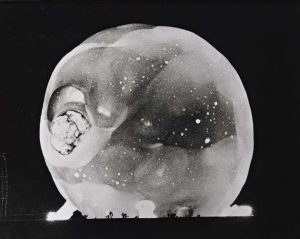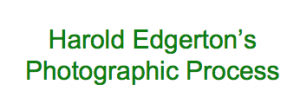
![]() MIT physicist and photographer Harold Edgerton is best known for his invention of strobe light photography, which enabled him to make extremely rapid exposures to freeze fast actions in time, such as a bullet piercing an apple. Beginning in 1947, Edgerton’s research firm, EG&G, was commissioned by the Atomic Energy Commission to photograph atomic bomb tests. Using a specially designed camera that could make exposures of 1/1,000,000th of a second, Edgerton and his associates photographed a series of bomb tests in Nevada and the Pacific.
MIT physicist and photographer Harold Edgerton is best known for his invention of strobe light photography, which enabled him to make extremely rapid exposures to freeze fast actions in time, such as a bullet piercing an apple. Beginning in 1947, Edgerton’s research firm, EG&G, was commissioned by the Atomic Energy Commission to photograph atomic bomb tests. Using a specially designed camera that could make exposures of 1/1,000,000th of a second, Edgerton and his associates photographed a series of bomb tests in Nevada and the Pacific.
 This photograph, probably of a bomb dubbed “How,” was likely taken on June 5, 1952, as part of Operation Tumbler-Snapper test series at the Nevada Proving Grounds. The Tumbler portion of the test, sponsored by the AEC, was intended to establish the optimum height of burst. The Joshua trees silhouetted at the base of the blast were incinerated milliseconds later. Edgerton also photographed bomb tests at Eniwetok Island in the Pacific Ocean.
This photograph, probably of a bomb dubbed “How,” was likely taken on June 5, 1952, as part of Operation Tumbler-Snapper test series at the Nevada Proving Grounds. The Tumbler portion of the test, sponsored by the AEC, was intended to establish the optimum height of burst. The Joshua trees silhouetted at the base of the blast were incinerated milliseconds later. Edgerton also photographed bomb tests at Eniwetok Island in the Pacific Ocean.
Like the meteorite that helped end the Cretaceous period 65 million years ago, nuclear detonations may mark a turning point in Earth’s geology.[footnote]David Biello, “Humans Leave a Telltale Residue on Earth,” Scientific American, January 7, 2016. https://www.scientificamerican.com/article/humans-leave-a-telltale-residue-on-earth1/. Accessed September 6, 2016. See also David Biellop, “Did the Anthropocene Begin in 1950 or 50,000 Years Ago?” Scientific American, April 2, 2015. https://www.scientificamerican.com/article/did-the-anthropocenebegin-in-1950-or-50-000-years-ago/ accessed November 23, 2016.[/footnote] Recently scientists have theorized about the beginnings of a new geologic epoch when humans have replaced nature as the dominant environmental force on Earth. At the International Geological Congress in 2016, the Working Group on the Anthropocene formally recommended designating the epoch “the Anthropocene.” Some scientists, including Jan Zalasiewicz, the chairman of the Working Group, argue that the Anthropocene epoch’s beginnings can be precisely dated to the Trinity atomic bomb test on June 16, 1945 at 5:29 am, when the world’s first atomic bomb was exploded in the New Mexico desert. Three human-induced radioactive isotopes that will take millennia or more to decay were released from this and the hundreds of subsequent detonations that followed. While some scientists link the new epoch to the rise of agriculture and the Neolithic revolution, and others date it to the dawn of the industrial revolution, in January 2015, 25 of the 38 members of the Anthropocene Working Group suggested the Trinity test as the start of the new epoch.[footnote]The Working Group on the Anthropocene’s paper was published in Science magazine on January 8 under the title “The Anthropocene is functionally and stratigraphically distinct from the Holocene.” See Ian Argus, “Anthropocene Working Group: Yes, a new epoch has begun,” Climate & Capitalism, January 9, 2016. http://climateandcapitalism.com/2016/01/09/anthropocene-working-group-yes-a-new-epoch-has-begun/. Accessed November 23, 2016.[/footnote]